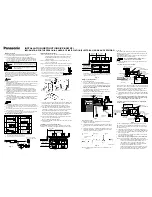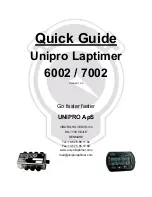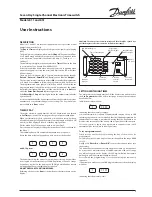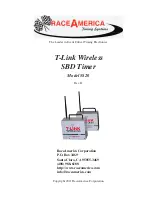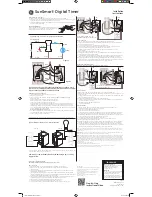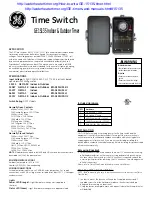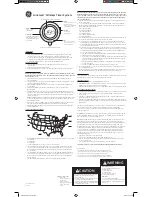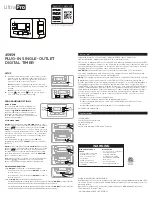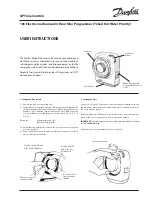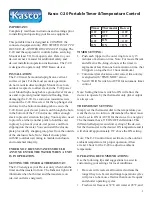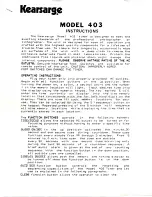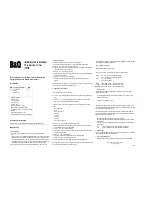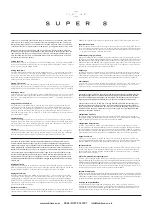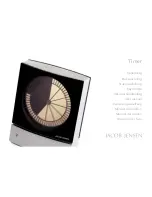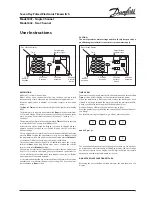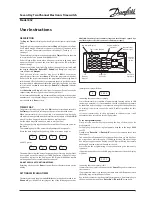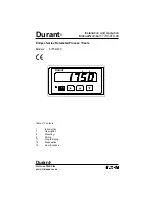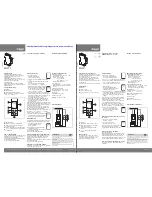
When installation work is completed, perform a test run and check that no
trouble occurs. Also be sure to explain the methods for using the product to
the customer, based on the contents of the Operation Manual. In addition,
request that the customer keep and conveniently store the “Information for the
Person in Charge of Installation (Electrical) Work and Servicing” together with
the Operation Manual.
Depending on the installation location, it may be necessary to install an
earth leakage breaker. Failure to do so may result in electrical shock or fire.
Do not install in kitchens, workshops, or other locations where there is oil
mist in the air.
Do not install next to windows or in other locations exposed to direct sun-
light or in direct contact with outside air.
Do not install near an elevator, automatic door, industrial sewing machine,
or other devices that can be expected to produce electrical noise.
(with current fuse) *1
T10 relay wire *2
Power wire for
connection to
system controller
1
2
3
4
5
6
7
8
1
1
1
2
2
7
1
1
1
Q'ty
Q'ty
Operating
Instructions
Wire joints
No.
No.
Supplied parts
Supplied parts
Spacers
Label
9
Earth screw for T10
(for indoor unit)
4 x 8 - 3
Screws
T10 power wire
M4 x 25
Accessories for Schedule Timer
Indoor unit control PCB
T10 connector (6P, yellow)
1. Power wire
2. Relay wire
Fig. 1
Fig. 4
Fig. 6
Fig. 3
(For connected
installation)
Remote controller
wiring outlet
Electric jinction box
More than
95 mm
More than 125 mm
(From wall)
More than
95 mm
More than
125 mm
(From wall)
(For connected
installation)
Remote controller
wiring outlet
Electric jinction box
* For maintenance reasons, leave a gap of 25 mm or more between the
remote controller switch and schedule timer if they are arranged in
parallel above/below each other.
1-1
1-2
2-2
1-3
2-3
2-1
3-1
System 1
System 2
System
3
Schedule timer
Inter-unit control
wiring
Wiring the Schedule Timer
Before beginning wiring
– Use 0.5 – 2 mm
2
wires for field supply wiring.
–
–
For inter-unit control wiring, use signal wires that allow the
remote controller wiring to be differentiated from the power
wiring, and take care to prevent miswiring.
(Miswiring will
damage the schedule timer.)
– Check that the schedule timer communications wiring and
power wiring are connected correctly. (Fig. 5)
<Basic Wiring Diagram>
Route the A/C inter-unit control wiring for central control as
shown in the figure below.
The maximum number of indoor units that can be connected to
a single system is 64. The maximum number of outdoor units is
30.
The maximum number of schedule timer units that can be con-
nected is 8. (A maximum of 10 schedule timer units and other
central control devices can be connected.)
WARNING
CAUTION
*1
*2
Installing the Schedule Timer
<Note 1> Avoid twisting the inter-unit control wiring or the input/out-
put wiring together with power or other wiring, and avoid
running them in the same metal conduit. Doing so can
cause malfunction.
<Note 2> Install the schedule timer at a location away from any
sources of electrical noise.
<Note 3> Install a noise filter or take other appropriate action if elec-
trical noise affects the power supply circuit of the unit.
(1) Open the panel on the schedule timer unit. Insert a standard (flat-
head) screwdriver or similar tool into the notches on the bottom of
the schedule timer unit to open and remove the back case.
(2) Use the 2 supplied M4 small screws and install the schedule
timer back case onto the switch box. Before installing, use a
screwdriver or similar tool to press on and open the screw holes
that correspond to the Electric jinction box that is used.
When fastening the case, use spacers and do not tighten the
screws too much. If the schedule timer does not fit tightly against
the wall, cut the spacers as required to make adjustments.
(3) Connect the supplied power wire (2-core) and inter-unit control
wire (3-core) to the schedule timer unit.
(Refer to “Wiring the Schedule Timer.”)
(4) Align the schedule timer unit with the tabs on the back case and
press to install it.
Installation of connected schedule timers
When installing schedule timers (remote controller switches, system
controllers, etc.) onto the wall, use the method shown in Figs. 3 and 4.
If power is supplied from the indoor unit control PCB of a nearby
indoor unit, connect the provided T10 terminal connection wires to
the T10 terminal on the indoor unit control PCB, and to the sched-
ule timer power wires.
The inter-unit control wiring has no polarity. The wiring may be
connected in either direction to U1 and U2. (Use shielded wiring)
If necessary, use a relay wire when connecting the wiring to the
indoor unit control PCB.
The power wiring has no polarity. The wiring may be connected
in reverse. (Use shielded wiring)
The length of the power wiring must be no more than 100 m.
<Note> The only functions of the schedule timer are indoor unit
ON/OFF and remote controller enable/disable operations. It
is therefore recommended that during installation, a sys-
tem controller, remote controller, or similar device be
installed next to the schedule timer so that the operation
mode and other information can be checked.
(If the system controller or other central control device is not
present, the schedule timer cannot be used in combination
with a system that does not utilize remote controllers.)
Wiring
The schedule timer wiring can be connected by the following two
methods. Select one of these connection methods according to the
actual installation location.
When wiring, extend the lengths of the wires using wire joints (pro-
vided) and extension wires (field supply).
When installing multiple schedule timers,
avoid the use of cross-over wiring.
Connection diagram (Be sure to use the provided wires as the
power wiring.)
If a system controller is also installed:
Connect the wires for the schedule timer inter-unit control wiring (see
Note below) to the U1 and U2 terminals on the system controller ter-
minal board. Connect the system controller power wiring to CN02
and to the schedule timer power wires (white + black).
The inter-unit control wiring has no polarity. The wiring may be
connected in either direction to U1 and U2. (Use shielded wiring)
The power wiring has no polarity. The wiring may be connected in
reverse.
The length of the power wiring must be no more than 100 m.
Note: The inter-unit control wires are pink + blue + blue (using
wire joint crimping). Use pink + blue wires.
If a system controller is not installed (power is supplied from
the indoor unit):
<Note> Depending on the model of A/C, a local adapter may be
required.
Safety Precautions
Read these Safety Precautions before beginning installation or electrical
work, and perform the work only in the correct manner.
Precautions in this manual are given in the form of “Warnings” or
“Cautions.” Both types of precautions contain important information relat-
ed to your safety, the safety of users, and the correct operation, installa-
tion, or maintenance of the air conditioning system. Be sure to carefully
observe all relevant precautions.
This symbol refers to a hazard or unsafe practice
which can result in severe personal injury or death.
This symbol refers to a hazard or unsafe practice
which can result in personal injury or product or
property damage.
WARNING
CAUTION
CAUTION
INSTALLATION INSTRUCTIONS(CZ-ESWC2)
INFORMATION FOR THE PERSON IN CHARGE OF INSTALLATION (ELECTRICAL) WORK AND SERVICING
When mounting the back case to the electric junction box,
tighten the screws securely until the screw heads touch the
back case. Otherwise, a loose screw head may damage the
PCB on the back of the top cover when mounting the top
cover. But do not over-tighten the screws. Overtightening
may deform the back case and cause the unit to fall.
Request installation and electrical work only from the dealer or a qualified
air conditioning specialist.
Attempting to carry out installation work on your own, and doing so incor-
rectly, may result in electrical shock, fire, or other hazards.
I
nstallation procedures must be performed correctly, carefully following
the instructions in this document.
Failure to do so may result in electrical shock, fire, or other hazards.
Electrical work must be performed by a qualified electrician. It must be
performed in accordance with technical standards related to electrical
equipment, interior wiring requlations, local codes, and the contents of
these instructions.
I
nsufficient power circuit capacity or improper electrical work may result in
electrical shock or fire.
Use only the designated cables for wiring, and connect them securely. Fasten
cables so that no external force is applied to the terminal connections.
Insufficient connections or cable fastening may result in heat generation,
fire, or other hazards.
Fig. 2
M4 x 25 small
flat-head screws (2
Wiring for earth (green) *3
)
Spacer
Under-case
(back case)
Electric jinction box
Decorative cover
(panel)
Schedule
timer unit
1
Do not allow a screwdriver or other
metal object to touch the PCB
terminals when the power is ON.
Pre-
cautions
Power
terminal
(remote
controller
terminal)
Permitted items for
controller operation
Permit all modes Permit the below items only
Prohibited items for controller operation
Current-time synchro-
nization communication
Temp
.
set
ting
Opr
.
mode
St
ar
t/
St
op
R
emot
e contr
oller pr
ohibit
not used.
Schedule timer address
Timer group setting
Connected device
Communi-
cations
terminal
All switches are
OFF when the unit
is shipped.
: OFF
: ON
1Gr
fixed
2Gr
fixed
3Gr
fixed
Manual
assignment
2
3
1
5
6
7
1
2
3
4
5
6
7
8
2
3
4
Inter-unit
communication
Remote controller
(4 wires)
Communications wiring
(Inter-unit control wiring)
Power wiring
Wiring outlet
Fig. 5
Fig. 7
Schedule
timer
Field supply
Field supply
(Use shielded wiring)
Communication
wiring
(pink + blue)
Power wiring
(white & black)
Wiring for earth
(green)
System controller
(Back side)
Inter-unit control wiring
(Use shielded wiring)
Fig. 8
T10
U1
U2
Indoor unit control
PCB
Inter-unit
1
Earth screw for T10
cable (Supplied parts 9).
Be sure to disconnect
the .
control wiring
Schedule
timer
Communication
wiring (pink + blue)
Power wiring
(white + black)
Indoor unit
Under-case
(back case)
Wiring for earth
(green)
Field supply
(Use Shielded Wiring)
*3 For used in North America, remove the wiring for earth (green)
on the back case.
Use shielded wiring for Inter-unit control wiring and power
wiring(T10). (Except North America)
Use it according to the form of T10 connector.
If the fuse blows as are sult of a wiring short-circuit, miswiring, or
overcurrent, replace it with a 125 V, 0.5 A fuse.

